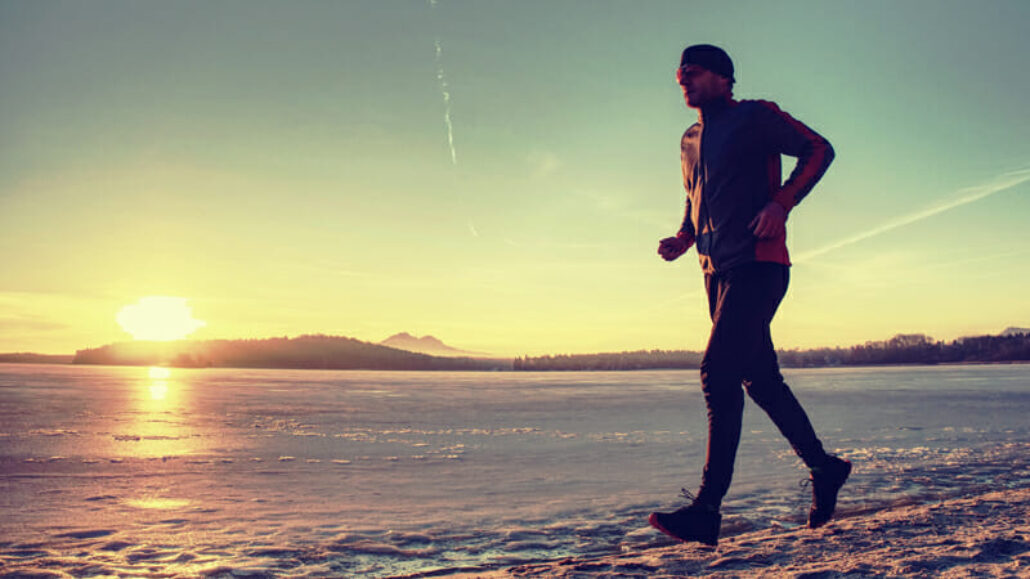Whether you are a casual runner or a seasoned marathoner, these tips will help you stay fit safely during Minnesota’s colder seasons.
Did all the fun at last week’s race inspire you to make running part of your fitness routine, even though snowflakes have begun to fall? There’s no reason to curtail outdoor running as the weather gets frosty. With a few safety guidelines, you can continue to running in cold weather throughout all but our most bitterly cold winter days.
Dr. Kirk Scofield of Summit Orthopedics suggests the following tips:
Drink Liquids
Remember to drink fluids. Dehydration is an issue in all seasons. Losing even 2 percent of your weight from sweat will lower your endurance. The rule of thumb is to drink for thirst—no more than one cup of fluid every 20 minutes.
Warm up inside before you go outside
The cold won’t feel so cold if you are warm when you begin. Don’t break a sweat, but do move around inside before you go out. Climb the stairs, do a few push-ups; whatever it takes to get the blood flowing.
Dress for the weather
The rule for cold weather runners is to dress as if it is 20 degrees warmer than it is. Dress in thin synthetic wicking layers that you can adjust as your body warms up. Your outermost layer should be wind resistant and waterproof. The trick is to avoid sweating brought on by too many layers; that can lead to a chill.
Wear a hat and gloves, and consider a face mask or scarf
If you are sensitive to cold weather, you might want to slip hand warmers in your gloves to stave off the cold. Daylight is limited in winter, so wear reflective, fluorescent gear that is easy for drivers to spot.
Male runners are wise to invest in windproof tights, windproof underwear, or other groin protection. Especially when windchill is an issue, windproof garments will help protect you from the risk of frostbite.
Look for running shoes that don’t have mesh
If the uppers are water repellent, even better. Socks should wick away wetness, but keep your feet warm. Check out traction devic
es that slip over shoes if your winter running route tends to be slippery.
Don’t stay in damp running clothes
Your body temperature drops as soon as you stop running. You’ll feel warm after you run, but it is important to get out of the cold quickly and change into dry clothes. If you drive to your running route, take a thermos of coffee or tea to sip as you drive home.
Know your limits
Cold temperatures restrict blood flow. If you feel stiff and try to force your pace, you could pull or tear a muscle. If there’s snow, ice, or water on your path, shorten your stride and pay attention to your footing.
Respect weather extremes
Strong wind removes the layer of warm, insulating air held within your layers of clothing. Snowy or icy conditions increase the risk that you’ll fall and injure yourself. If the temperature or the wind chill dips below zero, or if conditions are slick, forego your run and hit the treadmill instead.
Monitor your fingers, toes, ears, groin, and nose for frostbite Check with your doctor before you run
Even if your extremities feel numb at first, they should warm up in a few minutes. If you notice a patch of hard, pale, cold skin, get out of the cold immediately. If the numbness continues, seek medical help.
Check with your doctor before you run
If you have any medical conditions or concerns about the cold, don’t begin running until you’ve reviewed your plans with your doctor. In susceptible individuals, cold air can trigger chest pain or asthma attacks. Following these common sense tips will keep you safely active right through till next spring.
Summit Orthopedics offers comprehensive sports medicine expertise
From Olympians to pro athletes to kids in youth sports and those that just want to be more active—Summit Orthopedics delivers expert care by fellowship-trained sports medicine physicians. If you are recently injured or concerned about ongoing pain, Summit Orthopedics sports medicine specialists have the expertise to evaluate your discomfort and develop a plan to quickly and safely help you get back to being active.
Start your journey to stronger, healthier athletic condition. Find your sports medicine expert, request an appointment online, or call us at (651) 968–5201 to schedule a sports medicine consultation.
Summit has convenient locations across the Minneapolis-St. Paul metro area, serving Minnesota and western Wisconsin. We have state-of-the-art centers for comprehensive orthopedic care in Eagan, MN, Vadnais Heights, MN, Plymouth, MN, and Woodbury, MN, as well as several additional community clinics.
More resources for you
- Ask Dr. Skendzel: When Does Race Training Become Too Much Running?
- Are You Ready For A Marathon?
- Ask Sam Olson: What Are The Basics Of Good Running Form?

